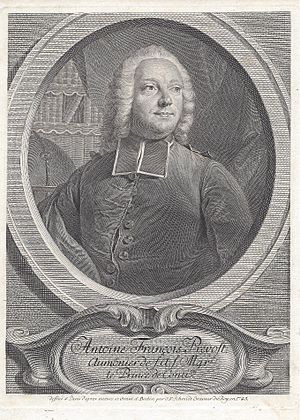Abbé Prévost facts for kids
Quick facts for kids
Abbé Prévost
|
|
|---|---|

Portrait by Georg Friedrich Schmidt, 1745
|
|
| Born |
Antoine François Prévost d'Exiles
1 April 1697 |
| Died | 25 November 1763 (aged 66) Courteuil, Picardy, France
|
Antoine François Prévost d'Exiles (born April 1, 1697 – died November 25, 1763), often known simply as the Abbé Prévost, was a French priest, writer, and novelist. He is best known for his famous novel Manon Lescaut.
Contents
Life of a Famous Writer
Antoine François Prévost was born in Hesdin, a town in France. His father, Lievin Prévost, was a lawyer. Antoine's childhood changed when he lost his mother and younger sister when he was 14 years old.
He went to a Jesuit school in Hesdin. In 1713, he joined the Jesuit order in Paris to continue his studies.
Early Adventures
In 1716, he left the Jesuits to join the army. But he soon got tired of military life. He returned to Paris in 1719, thinking about rejoining the Jesuits. He traveled in the Netherlands around this time. He then joined the army again, this time as an officer.
Later, he found a new home with the Benedictine monks of St Maur. He said he sought refuge there after a difficult time in his life. He became a monk in 1721 and a priest in 1726. For seven years, he lived in different monasteries, teaching, preaching, and studying.
In 1728, he was sent to a monastery in Paris. There, he helped with a big history project called Gallia Christiana. But his adventurous spirit made him want to leave the strict rules of the Benedictines. He left the monastery without permission in 1728. When he learned that his superiors had issued a special order called a lettre de cachet (a letter from the king ordering someone's arrest or imprisonment) against him, he quickly fled to England.
Writing in England and the Netherlands
While living in London, Prévost learned a lot about English history and literature. This knowledge showed up in his later books. Before leaving the Benedictines, he had started writing his most famous novel, Mémoires et aventures d'un homme de qualité qui s'est retiré du monde. The first four parts of this book were published in Paris in 1728.
In 1729, he moved from England to the Netherlands. There, he started publishing another novel called Le Philosophe anglais, ou Histoire de Monsieur Cleveland.
While in the Hague, he worked on translating a historical book. He also published more parts of his first book, which included the very famous story Manon Lescaut. This story was published separately in Paris in 1731. People loved reading Manon Lescaut, even though it was forbidden in France and mostly read through illegal copies.
In 1733, he moved back to London. There, he started a weekly newspaper called Le Pour et contre. It was similar to a popular English newspaper of the time. He continued to write for this paper until 1740.
Return to France and Later Life
In 1734, Prévost made peace with the Benedictines and returned to France. He was allowed to live outside a monastery in 1735, becoming a chaplain to a French prince. Later, in 1754, he became the head of a small monastery.
He kept writing novels and translating books from English. Except for a short time (1741–1742) when he lived in Brussels and Frankfurt, he mostly stayed in Chantilly, France. He died suddenly in 1763 while walking in the nearby woods. The cause of his death was a burst blood vessel.
Other Works by Abbé Prévost
Abbé Prévost wrote many other books and translations, including:
- Le Doyen de Killerine (1735)
- Tout pour l'amour (1735), a translation of a play by John Dryden
- Histoire d'une Grecque moderne (1740)
- Histoire de Marguerite d'Anjou (1740)
- Mémoires pour servir a l'histoire de Malte (1741)
- Campagnes philosophiques (1741)
- Histoire de Guillaume le Conquérant (1742)
- Voyages du capitaine Robert Lade (1744), a made-up travel story
- Histoire générale des voyages (1746–1759), a large history of travels
- Manuel Lexique (1750), a dictionary
- Translations of novels by Samuel Richardson, like Pamela (1741) and Clarissa (1751)
- Mémoires pour servir a l'histoire de la vertu (1762), a translation of a book by Mrs Sheridan
- Histoire de la maison de Stuart (1740), a translation of a history book by David Hume
- Le Monde moral (1760)
See also
 In Spanish: Abate Prévost para niños
In Spanish: Abate Prévost para niños

